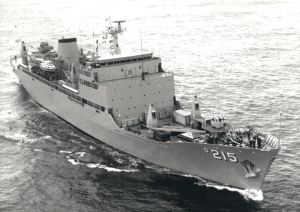- Author
- Midson, D.W., BSc LLB (Hons), Acting Sub Lieutenant, RAN
- Subjects
- Ship design and development
- Tags
-
- RAN Ships
- HMAS Stalwart II, HMAS Tobruk II
- Publication
- March 2011 edition of the Naval Historical Review (all rights reserved)
David Midson studied science and law at the University of Tasmania before joining the RAN in 2008. Following New Entry Officer Courses at HMAS Creswell he began work as a legal officer in late 2009. Recently promoted to Lieutenant, he is now doing Legal Rotation which involves carrying out a variety of postings in the Canberra area for three to six months at a time.
Note: For reasons of space, footnotes and bibliography have been omitted. The full text of this essay is available on request to the Naval Historical Society.
Introduction
A toxic hazard is the one of the greatest threats to those aboard a naval ship in peace time. They can cause serious injury or death and unfortunately they are not uncommon. The RAN has recorded many thousands of toxic hazard incidents of varying degrees over its history. Whilst a variety of chemicals can cause a hazard, the most commonly fatal of these is Hydrogen Sulphide (H2S).

Image courtesy of RAN
This paper will examine the history of H2S incidents in the RAN in order to identify lessons to be learnt from the past. The paper begins by discussing the nature of H2S hazards and how H2S incidents have increased due to international regulation. This paper will then discuss two defining H2S incidents in the RAN and the lessons learnt from them. Those discussed will be the 1985 incident aboard HMAS Stalwart and the 1981 incident aboard HMAS Tobruk.
Finally this paper will conclude by reference to the lessons to be learnt from these incidents.
Causes Of Hydrogen Sulphide Toxic Hazards
Hydrogen Sulphide is a simple chemical, consisting of one atom of Sulphur and two of Hydrogen, but its simplicity belies its lethality. This small chemical can have a devastating effect on human physiology, beginning with respiratory irritation and ending in asphyxiation. It is a silent killer, at relatively low concentrations it shuts down the olfactory sense, meaning its presence cannot be detected. There are electronic and chemical detection devices that can provide an early warning, but these will only provide protection when they are in effective working condition.
This toxic gas is potentially within many areas of the ship but the most important sources are stored sewage and oily-waste compartments. In both cases bacteria utilise the microbial food available in sewage or oily waste to generate H2S which then accumulates to potentially lethal quantities in closed compartments.
Hydrogen Sulphide toxic hazards are a relatively recent problem, largely occurring since the 1980s. Ironically, a primary cause for the rise in the prevalence of H2S hazards has been international environmental regulation. In 1972 and 1973 respectively the Convention on the Prevention of Marine Pollution by the Dumping of Wastes and other Matter and the Convention for the Prevention of Pollution from Ships (MARPOL Convention) were created. These conventions together with subsequent protocols have provided an international regulatory framework on how waste is disposed of at sea. Importantly both conventions place limits on the disposal of oily wastes and sewage, meaning that such wastes have to be stored on board since those conventions came into force.
It was this change in regulation that in a sense created a H2S problem which had long been avoided by dumping such waste overboard. It was as these regulations were being adopted by the RAN that the incidents aboard Stalwart and Tobruk occurred.
HMAS Stalwart
Stalwart was a destroyer tender designed to provide afloat support for the RAN. In 1985, almost twenty years after it was commissioned, Stalwart suffered one of Australia’s worst toxic hazard incidents. On the 22nd October 1985, as the sewage tanks were being pumped, H2S gas leaked into the ship causing three fatalities and sixty injuries. Following the incident, action was taken immediately and gas detection devices were fitted.
The Stalwart incident led to an inquiry resulting in changes to the procedures used by the RAN in responding to toxic hazards. The inquiry found that many of the injuries were caused by people moving into the contaminated spaces to rescue shipmates.
Whilst the intention of the rescuers was noble it led to more casualties. The procedure was changed so that a rescue cannot be attempted until proper breathing apparatus is being worn. These changes have helped prevent a reoccurrence of the injuries that occurred on Stalwart.
HMAS Tobruk
Tobruk has a distinguished record of service in Australia and overseas, however it has suffered from technical problems. In her early period of service she suffered many problems with sewerage plant and these problems led to a most tragic incident. On the 14th of December 1981, a naval cadet, Kenneth Dax, was gassed whilst he vomited into the heads. The parliamentary inquiry that followed was not impressed by the RAN response to the incident. The inquiry found that the sewerage system was of inadequate design and that many known risks of H2S developing onboard, had been overlooked or ignored.




